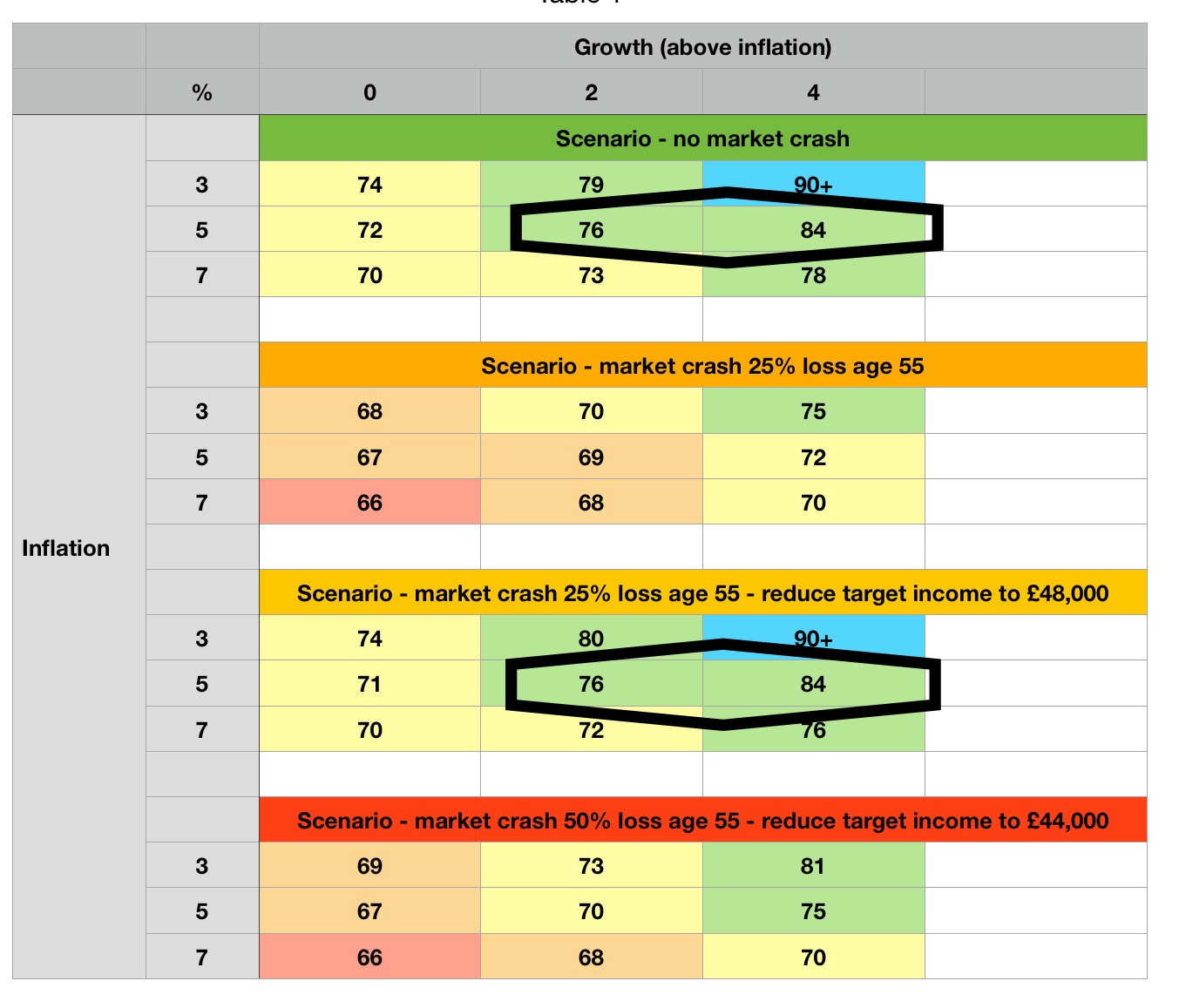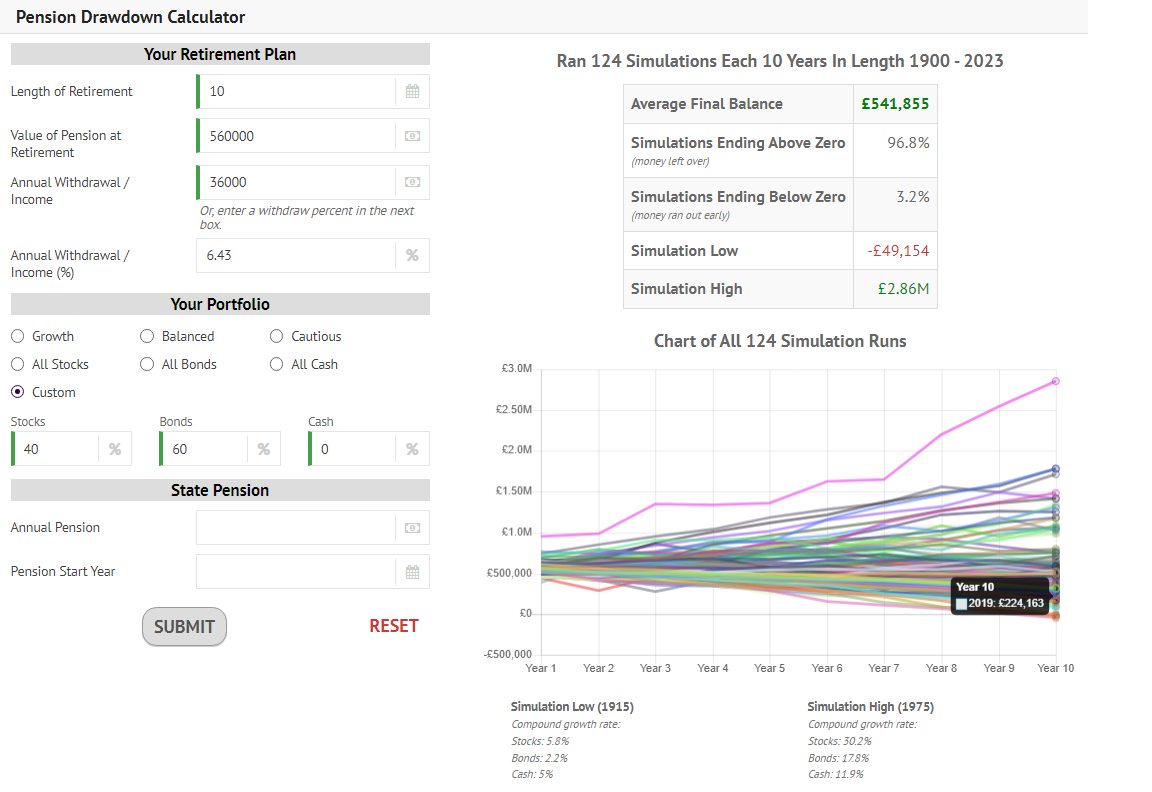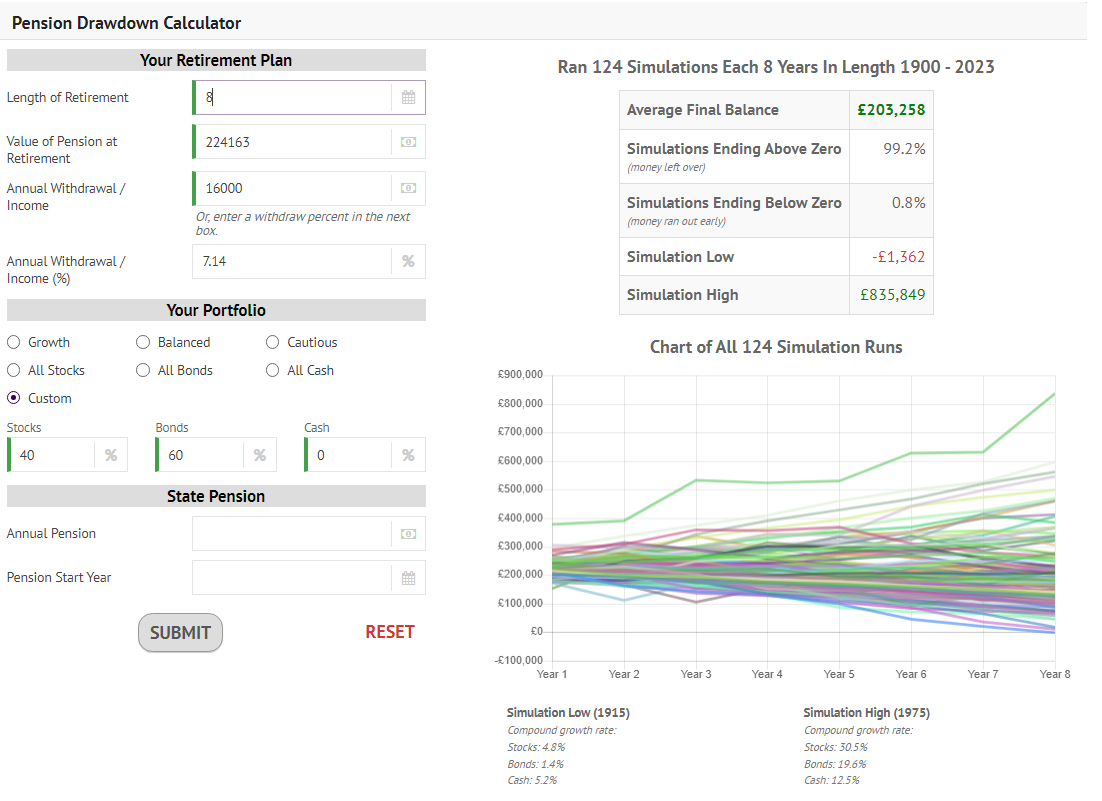We’d like to remind Forumites to please avoid political debate on the Forum.
This is to keep it a safe and useful space for MoneySaving discussions. Threads that are – or become – political in nature may be removed in line with the Forum’s rules. Thank you for your understanding.
📨 Have you signed up to the Forum's new Email Digest yet? Get a selection of trending threads sent straight to your inbox daily, weekly or monthly!
What to expect from an IFA?
Comments
-
If I assume 3% inflation and zero growth above inflation then our pot runs out at 71. I can live with that.2% above inflation and its 80+
4% above and it would never run out.
If inflation over the long term is significantly higher than 3% then it drops a little bit.
If our pot runs out the I guess I can always get another job selling crystal balls.....1 -
Out of interest (no pun intended) how would you suggest I can attempt to model a 30 year projection without using straight-line assumptions?dunstonh said:Just remember that straight-line projecting is considered obsolete and risky. You should run the same modelling with much more pessimistic figures if you are using that method.
I could assume a variable pattern using the data from the last few decades but no-one at the time was predicting a decade of virtually zero growth followed by such a massive explosion in inflation across a couple of years and it's unlikely to repeat itself in that same manner next time around.
I think the key is to monitor actuals against your original plan and adjust year to year as you go along. e.g. if there are a couple of years of lower than expected growth or lower increases in allowances then be willing to take a little less the next year to try and preserve the pot. If on the other hand the actuals are doing better than the plan then there is always the option to either take a little more and/or move some money across to guaranteed income.
0 -
Out of interest (no pun intended) how would you suggest I can attempt to model a 30 year projection without using straight-line assumptions?Run a range of pessimistic figures and do one that suffers an immediate 25% loss.
No-one using investments for income is worried about the upside. Its the downside that matters and Sequence risk that causes the most damage. If you can get through that, then great.I could assume a variable pattern using the data from the last few decades but no-one at the time was predicting a decade of virtually zero growth followed by such a massive explosion in inflation across a couple of years and it's unlikely to repeat itself in that same manner next time around.Every cause is different but things do have a habit of repeating themselves. If you had started around 1968, you would have had a very poor run. Amongst the worst in 100 years. It was just before an energy crisis followed by high inflation.
What you learn when doing this long enough is that you cannot predict anything and that often the same mistakes get made again and again. So, don't predict the future but look at what has happened in the past. If you could survive the majority of the events of the 20th century, then there is a pretty good chance you would survive the majority of the events of the 21st century. Modelling is not easy. Even if you modelled tens of thousands of scenarios, your actual scenario will play out differently.I am an Independent Financial Adviser (IFA). The comments I make are just my opinion and are for discussion purposes only. They are not financial advice and you should not treat them as such. If you feel an area discussed may be relevant to you, then please seek advice from an Independent Financial Adviser local to you.3 -
That's a very good idea, thanks.dunstonh said:Out of interest (no pun intended) how would you suggest I can attempt to model a 30 year projection without using straight-line assumptions?Run a range of pessimistic figures and do one that suffers an immediate 25% loss.
No-one using investments for income is worried about the upside. It's the downside that matters and Sequence risk that causes the most damage. If you can get through that, then great.So in that scenario the DC pot starts out at £419k and still assuming 3% interest and then 5% recovery growth the pot runs out at 71. However if the pot did take such a huge hit then in reality I would be tightening the belt and taking less than £54k after tax to help balance the longer term.1 -
Going back to your original question - one thing you should expect from a good IFA / financial planner is that they will run these scenarios for you, not only using spreadsheets, but using commercially available modelling software. Some of this software has the ability to compare your planned withdrawals against all of past history of the stock markets, inflation and so on, and then give you a percent probability that your plan would have succeeded in the past. That would include testing it against 1968 as DunstonH mentioned.GenX0212 said:* Re-posted here as mistakenly posted in the wrong forum earlier *
So, me and my wife are thinking of retiring fairly soon and I have spent quite some time building a detailed model/plan to see what's possible.
As a quick summary:Me:- Age 55
- A deferred DB pension available from age 55 approx £14k a year
- A current workplace DC pension current value > £400k, low costs ~0.25%, flexible options, no drawdown fees, performing well.
- A couple of other private pensions, total about £100k. Mid costs ~0.6 to 0.8 %
- A Full State Pension expected. 38 full years so far.
Her:- Age 55
- A deferred DB pension available from age 55 approx £4K a year
- A small robopension pot of about £18k. 0.8% costs
- A Full State Pension expected. 37 full years so far.
The aim is to retire from 55/56 with a Comfortable living standard (based on last months PLSA numbers) until at least age 75 and Moderate (or better) thereafter. We expect to need less as we become older.
I have modelled 3% inflation and 2% growth and the pot doesn't run out until after 80.
With 3% inflation and 0% growth then the pot would run out around 72 but we will still have a guaranteed minimum of a Moderate living standard at all times.If I die before 67 then my wife would have a £12k pension (hers plus widows) plus the pots; £22k after 67 plus the pots.
If there is a market crash before we are 67 then we have a combined guaranteed pension of £18k plus whatever is left from the pots.
With our DB pensions and State Pensions we would have a guaranteed Moderate living standard when we reach 67 regardless of what's left in the pot.The plan draws the money down in a tax efficient way, me staying below the 40% tax bracket and my wife only paying a small amount of tax when she starts drawing her State pension.
I'm aware of the option for me to transfer £2.8k to her each year before 67 in order for her to get £3.6k. I'm also aware of the Married persons tax allowance to gain a few hundred pound more each year.
Clearly we aren't going to attempt to transfer the DB pensions and unless something changes drastically then I see no reason to move away from my current DC scheme although I would likely reduce the investment risk profile. I would be happy with the return of 2% growth and have no interest in investing in any high risk strategies.
If an IFA is charging 1-2% of my pot for advice (£5k - £10k) am I likely to get a real return on the money or am I likely to get a 'yeah all looks ok' response for the money? I have no objection whatsoever to paying the £10k if I am likely to get some value out of it.
Would love to hear others experience of using an IFA and the value they got from doing so, equally from anyone who didn't then do you have any regrets?
If it shows 100% it means your plan would have succeeded in all past scenarios, including 2 world wars, the great depression, the 1968 oil crisis and so on, but it also means that you have 80% plus chance of ending up the richest person in the graveyard (or with plenty to pass on).
That's why from what I've heard, some would say that it should be perfectly fine to retire with a success of maybe 85-95% and be prepared to make some minor timing adjustments in your spending, and using cash buckets to reduce any sequence of return risk. If you are not prepared to accept any possibility to make such adjustments, arguably you should be buying an annuity in the first place.
Some IFAs will do this for you for a one off fee, without the need to sign up to any long term agreements.2 -
A normal way to model multiple returns sequences and scenarios is Montecarlo Simulation. Which involves generating a lot of "random" series of returns one after the other. And then assessing the outcomes of each.
A key statistical assumption on which most tools that do this rests is that the distributions of behaviour are "normal" in mathematical terms. There is a school of thought in economics and finance which does not think that this entirely holds for retail financial markets - so called "fat tails" and see also Taleb and his Black Swans.
Nonetheless. As an alternative to "single value" modelling or doing a few High/Medium/Low inflation "sets of assumptions" around returns. You can instead run MC simulation, for free.
You either can folllow Larse Kroijer's financial model building tutorials to do it in Excel/Libre Office on Youtube.
I think he got bored in lockdown. Or you can download a tool - one of which is FlexibleRetirementPlanner - which does exactly this. It also handily plots a heat map on pairs of axes of choice around ranges of income, inflation and returns. And calculates % shortfalls/failures across 1000s of simulated runs. It is a US tool but it is very simple to zero out US taxation features and let it just do asset class returns, inflation and income
Cleary not as flexible as a full fat retiremement simulator - paid for software used by advisers.
There is a web version which I have not used as I dislike the data policies around such things. And a PC downloadable local version - which I have played with. Have fun
To use these tools does require you to think about the "width" of the normal distribution to be simulated - the standard deviation of returns, or inflation, that you expect and which bound the simulation. This is something you can take from historic market values if you think the past will resemble the future in broad shape. Or you can choose something n% broader (or narrower) remembering garbage in, garbage out.
Any simulation or "adjusted" backtesting data set can always be made one step worse. So any plan can be made to look like it can fail - if you work hard enough at layering on more assumed crises and aggressive test conditions.
0 -
Here's some simple modelling I did for various different projections:

Using an assumption of 2% average real growth (above inflation) and an average inflation rate of 5% it looks like my target of £54k a year from retirement to min age 75, £38k thereafter is doable.
In the event of a market loss of 25% then by reducing my desired income to £48k then I can maintain that until min age 75 and £38k thereafter.
I think both those scenarios are actually fairly pessimistic projections and I would be hoping to achieve around 4% real growth.
I'm thinking of using the 4 scenarios highlighted as my different planning scenarios - thoughts welcome!1 -
As an additional update I found the following calculator online and pumped in my figures Retirement Withdrawal Calculator | Wealth Meta
Part1: Drawdown for 10 years to State Pension age
Starting Balance £560,000
Required Income £36,000 (£54,000 less £18k in DB pension payments)
Required term 10
Selecting a low recent simulation (many other results in that percentile region were from the early 1900's) it gave a figure of £224,163 as the ending balance.
I then used this same figure to calculate forward from age 67-75:
After 75 then we would have at the very least a Comfortable standard based on DB pensions and 2 State Pensions and possibly quite a bit more.
So the calculator would seem to backup my own pessimistic forecasts.
NB. I'm aware that the professional IFA calculators can test a much wider ranger of simulations.0 -
As an additional update I found the following calculator online and pumped in my figures Retirement Withdrawal Calculator | Wealth MetaIts interesting that the simulation low (1915) showed a compound growth rate of 4.8%.
The decade from 2000 to 2009 (10 year period) was negative for stocks. I would have thought that a 10 year slice low would have showed a negative and not growth.
I am an Independent Financial Adviser (IFA). The comments I make are just my opinion and are for discussion purposes only. They are not financial advice and you should not treat them as such. If you feel an area discussed may be relevant to you, then please seek advice from an Independent Financial Adviser local to you.0 -
Looking at the screen shot, it is 60% in bonds - would that help to explain it?dunstonh said:As an additional update I found the following calculator online and pumped in my figures Retirement Withdrawal Calculator | Wealth MetaIts interesting that the simulation low (1915) showed a compound growth rate of 4.8%.
The decade from 2000 to 2009 (10 year period) was negative for stocks. I would have thought that a 10 year slice low would have showed a negative and not growth.0
Confirm your email address to Create Threads and Reply

Categories
- All Categories
- 352.8K Banking & Borrowing
- 253.8K Reduce Debt & Boost Income
- 454.7K Spending & Discounts
- 245.9K Work, Benefits & Business
- 601.9K Mortgages, Homes & Bills
- 177.8K Life & Family
- 259.8K Travel & Transport
- 1.5M Hobbies & Leisure
- 16K Discuss & Feedback
- 37.7K Read-Only Boards



